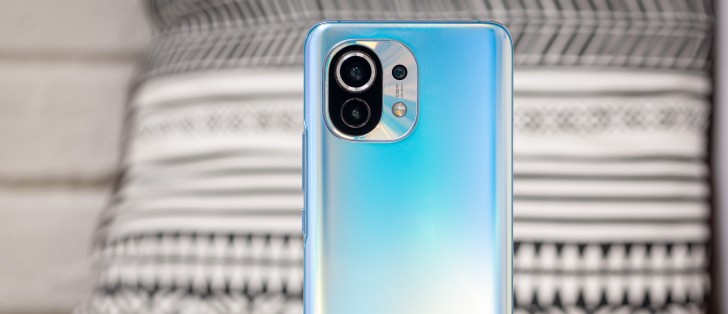Xiaomi Mi 11 review

Video quality
The Xiaomi Mi 11 offers many recording options and a ton of video effects you can use to spice up your captures. The main camera of the Mi 11supports 8K videos at 30fps, as well as 4K at 24fps, 30fps, and 60fps. The ultrawide camera maxes out at 4K at 30fps, while the macro cam can do 1080p@30fps.

There is 4-axis optical stabilization available on the main camera, while (optional) electronic stabilization is available on all snappers but the macro.
Then there's the Super steady Mode shot with the main camera - it focuses more on stabilization rather than quality, as an action-camera would do.
First, let's talk about the video quality and then we'll move to the new video effects, which the Mi 11 us supposed to pioneer.
Before we dig into the video side of things, let's mention that the audio in all of the videos is captured at 96Kbps, stereo. The low bitrate didn't result into awful audio captures, but we did expect more. The Mi 10 Pro, for example, offers 320Kbps audio.
The first clip we shot was in 8K at 30fps. We expected a rather poor video, but we were surprised to find it incredibly detailed and sharp, just look at the foliage, and presenting excellent colors and contrast. The dynamic range is commendable, too.
The footage isn't ideal - we observed what looked like compression artifacts. They could be a result of the Quad-Bayer nature of the sensor, or indeed compression trances. Anyway, those don't ruin our beyond positive impressions and this is among the 8K videos we found not to be a gimmick, but something worth using if you really need 8K capturing.
The 4K clips we shot at both 30fps and 60fps are outstanding. The detail is abundant, the noise is low, and they excel in everything else - smoothness, sharpness, colors and contrast. The high video bitrate (50+Mbps) surely helped, too.
Zooming 2x times is also an option in both 4K and 1080p recording modes. The amount of detail on the 2x zoomed 4K video is impressivly high for a digitally zoomed footage, though not surprising given the high-res sensor.
The low-light 4K30 fps videos from the main camera are brilliant, too. The noise is kept impressively low and this did not come at the expense of fine detail. No, the night clip is rich in detail, with balanced exposure and preserved colors.
The 4K footage (available only at 30fps) from the ultrawide camera is a bit disappointing. While it does offer good sharpness, accurate colors and good dynamic, they exhibit rather high noise levels that get nearly quality ruining in areas of uniform colors (like buildings).
Optical stabilization is always available on the main camera. The electronic stabilization works on both the main and ultrawide camera and it was enabled by default. EIS comes at the expense of a minor loss of FoV you will get nicely stabilized footage.
And here is the Xiaomi Mi 11 in our video comparison database.



2160p: Xiaomi Mi 11 against the Xiaomi Mi 10 5G and the Samsung Galaxy S21+ 5G in our Video compare tool
Video modes
You can also use the Super Steady Mode - it shoots a 1080p@30fps video that is as steady as one taken with an action camera. While it's not recommended to do with the Mi 11 what you could with, say, a Mi Action Camera, we are sure if an occasion arises, the Mi 11 will be up for the job.
There are a few exclusive Video Modes the Xiaomi Mi 11 has in its bag of video tricks - Magic Zoom, Slow Shutter, Time Freeze, Night-mode timelapse, Parallel World, and Night Mode Video.

Magic zoom keeps you subjects steady at the center of the frame, while slowly zooms in on the background. Slow Shutter blurs the background (mostly used at night), and is a good effect to focus on your subject at night and blur everything else (suitable for moving subjects and if the phone is not on a tripod, you could recreate dizziness or sickness).
Magic Zoom is available only in 1080p resolution.
The Time Freeze freezes parts on your frame, while keeping the other parts moving. And when you decide, you can unfreeze said parts and things will continue to move from the moment they were paused. Not all scenes are suitable for this effect (an overcrowded boulevard is not, for example), but still it's a nice effect provided you have the right purpose for it.
Time Freeze is also shot in 1080p.
The Night TimeLapse takes Night Mode photos, which are then stitched into a video. That's the reason while 1s of NTL takes 5+ minutes to capture and the 10s clips you are about to see took nearly an hour to make. NTL are shot in 4K and are stunning! If you find the right scene, you have enough juice in the phone, and it's not freezing cold out there, you will have a video you can really show off with and rightfully so.
And here is a regular Time-lapse we did over the course of 5 minutes. It was shot in 1080p, though 4K is available, too.
Parallel world recreates the Inception effect we saw in this popular movie a while back. It splits the frame in half, 1080p again, mirrors the bottom part at the top and slowly zooms in. There is a limit of 10 seconds for each clip.
Well, the parallel videos do look super nice, but we doubt many will use them often - there are too many limitations - low resolution, time limit, auto zoom.
We expected a lot from then Night Mode Video, yet we were a bit disappointed. The videos are shot in 1080p, digitally zoomed and you can see the toll that zoom took. If there is some light, there isn't much of a visible improvement. See the video below.
But this Ultra Night Video mode (you choose Night Mode and then switch to Video) was made for really dark occasions, say with just 1 lux luminance. Here, the night mode really comes into its own. Sure, the sharpness isn't stellar, there is still significant cropping and heavy noise reduction. But, instead of pitch-black footage, you get a somewhat usable picture, with visible detail and color.
We tested this mode in our studio at 1 lux and we've prepared a couple of screen grabs so you can easily see the difference.
And here are the untouched snaps from the 1080p clips.
Reader comments
- Anonymous
- 20 May 2023
- 7Xv
Absolutely true
- AnonD-814624
- 11 Jun 2022
- DVE
This is a well known issue with the mi11 series. There is a problem with the deisgn with a large number of units suffering from burnt motherboards and wifi. Xiaomi has acknowledged this problem and have offerered replacement rather than repair if it ...
- Anonymous
- 01 May 2022
- TRF
Very poor quality control. This is my fourth trip the service centre over the same issue. The motherboard and related WiFi and sound issues keep resurfacing even though after the third trip they replaced the phone.



